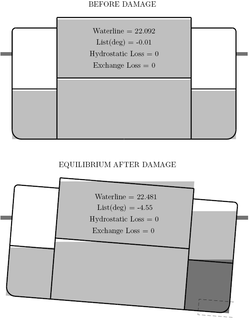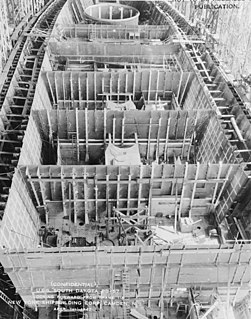A double-hulled tanker refers to an oil tanker which has a double hull. They reduce the likelihood of leaks occurring compared to single-hulled tankers, and their ability to prevent or reduce oil spills led to double hulls being standardized for oil tankers and other types of ships including by the International Convention for the Prevention of Pollution from Ships or MARPOL Convention. After the Exxon Valdez oil spill disaster in Alaska in 1989, the US Government required all new oil tankers built for use between US ports to be equipped with a full double hull.

A bulk carrier,bulker is a merchant ship specially designed to transport unpackaged bulk cargo, such as grains, coal, ore, steel coils and cement, in its cargo holds. Since the first specialized bulk carrier was built in 1852, economic forces have led to continued development of these ships, resulting in increased size and sophistication. Today's bulk carriers are specially designed to maximize capacity, safety, efficiency, and durability.

MT Mastera is a Finnish Aframax crude oil tanker operated by Neste Shipping. She and her sister ship, Tempera, were the first ships to utilize the double acting tanker (DAT) concept in which the vessel is designed to travel ahead in open water and astern in severe ice conditions. The icebreaking tanker transports crude oil year-round from the Russian oil terminal in Primorsk to Neste Oil refineries in Porvoo and Naantali.

La Noumbi is a floating production storage and offloading (FPSO) unit operated by Perenco. The vessel, converted from the former Finnish Aframax crude oil tanker Tempera by Keppel Corporation, will replace an older FPSO unit in the Yombo field off the Republic of Congo in 2018.
Ballast is used in ships to provide moment to resist the lateral forces on the hull. Insufficiently ballasted boats tend to tip or heel excessively in high winds. Too much heel may result in the boat/ship capsizing. If a sailing vessel should need to voyage without cargo then ballast of little or no value would be loaded to keep the vessel upright. Some or all of this ballast would then be discarded when cargo was loaded.
A double hull is a ship hull design and construction method where the bottom and sides of the ship have two complete layers of watertight hull surface: one outer layer forming the normal hull of the ship, and a second inner hull which is some distance inboard, typically by a few feet, which forms a redundant barrier to seawater in case the outer hull is damaged and leaks.
The strength of ships is a topic of key interest to naval architects and shipbuilders. Ships which are built too strong are heavy, slow, and cost extra money to build and operate since they weigh more, whilst ships which are built too weakly suffer from minor hull damage and in some extreme cases catastrophic failure and sinking.

An oil terminal is an industrial facility for the storage of oil, petroleum and petrochemical products, and from which these products are transported to end users or other storage facilities. An oil terminal typically has a variety of above or below ground tankage; facilities for inter-tank transfer; pumping facilities; loading gantries for filling road tankers or barges; ship loading/unloading equipment at marine terminals; and pipeline connections.

A ballast tank is a compartment within a boat, ship or other floating structure that holds water, which is used as ballast to provide stability for a vessel. Using water in a tank provides easier weight adjustment than the stone or iron ballast used in older vessels. It also makes it easy for the crew to reduce a vessel's draft when they enter shallower water, by temporarily pumping out ballast. Airships use ballast tanks for similar advantages.

A submarine hull has two major components, the light hull and the pressure hull. The light hull of a submarine is the outer non-watertight hull which provides a hydrodynamically efficient shape. The pressure hull is the inner hull of a submarine that maintains structural integrity with the difference between outside and inside pressure at depth.
The Stability conditions of watercraft are the various standard loading configurations to which a ship, boat, or offshore platform may be subjected. They are recognized by classification societies such as Det Norske Veritas, Lloyd's Register and American Bureau of Shipping (ABS). Classification societies follow rules and guidelines laid down by International Convention for the Safety of Life at Sea (SOLAS) conventions, the International Maritime Organization and laws of the country under which the vessel is flagged, such as the Code of Federal Regulations.

MV Drake, previously known as Pasha Bulker, is a Panamax bulk carrier of 76,741 tonnes deadweight (DWT) operated by the Lauritzen Bulkers shipping company and owned by Japanese Disponent Owners. While waiting in the open ocean outside the harbour to load coal, Pasha Bulker ran aground during a major storm on 8 June 2007 on Nobbys Beach in Newcastle, New South Wales, Australia. It was refloated and moved to a safe location offshore on 2 July 2007 at 9:48 p.m. AEST before being towed to Japan for major repairs on 26 July 2007.

An LNG carrier is a tank ship designed for transporting liquefied natural gas (LNG). As the LNG market grows rapidly, the fleet of LNG carriers continues to experience tremendous growth.

An oil tanker, also known as a petroleum tanker, is a ship designed for the bulk transport of oil or its products. There are two basic types of oil tankers: crude tankers and product tankers. Crude tankers move large quantities of unrefined crude oil from its point of extraction to refineries. For example, moving crude oil from oil wells in a producing country to refineries in another country. Product tankers, generally much smaller, are designed to move refined products from refineries to points near consuming markets. For example, moving gasoline from refineries in Europe to consumer markets in Nigeria and other West African nations.

The Coulombi Egg Tanker is a design that is aimed at reducing oil spills. It was approved by the International Maritime Organization (IMO) as an alternative to the double hull concept. The United States Coast Guard does not allow this design to enter US waters, effectively preventing it from being built.
Oil tankers generally have from 8 to 12 tanks. Each tank is split into two or three independent compartments by fore-and-aft bulkheads. The tanks are numbered with tank one being the forwardmost. Individual compartments are referred to by the tank number and the athwartships position, such as "one port", "three starboard", or "six center."
Corrosion in Ballast Tanks is the deterioration process where the surface of a ballast tank progresses from microblistering, to hydroscaletric electration, and finally to cracking of the tank steel itself.

A compartment is a portion of the space within a ship defined vertically between decks and horizontally between bulkheads. It is analogous to a room within a building, and may provide watertight subdivision of the ship's hull important in retaining buoyancy if the hull is damaged. Subdivision of a ship's hull into watertight compartments is called compartmentation.

An hydraulic tanker is an oil tanker designed to use water as an incompressible fluid for loading and unloading petroleum cargo. Each cargo tank is kept full at all times so oil floating on water will be pressed against the top of the tank. A cargo tank initially filled with water is loaded with the desired quantity of oil by pumping oil into the top of the tank displacing water which overflows through an opening at the bottom of the tank. The cargo tank is unloaded by removing oil from the top of the tank as water is admitted at the bottom.
MV Stellar Daisy was a South Korean-owned very large ore carrier (VLOC) that sank on March 31, 2017 in the South Atlantic off the coast of Uruguay while on a voyage from Brazil to China. She was the largest ship, by a factor of over three on gross tonnage, to be lost at sea.












